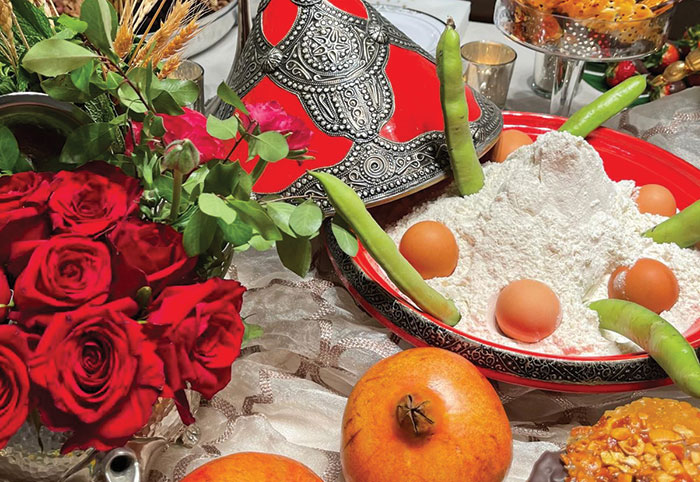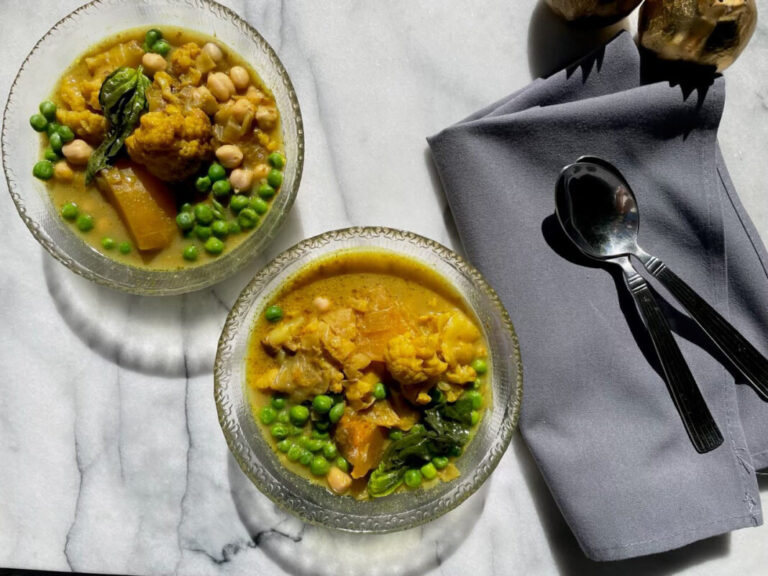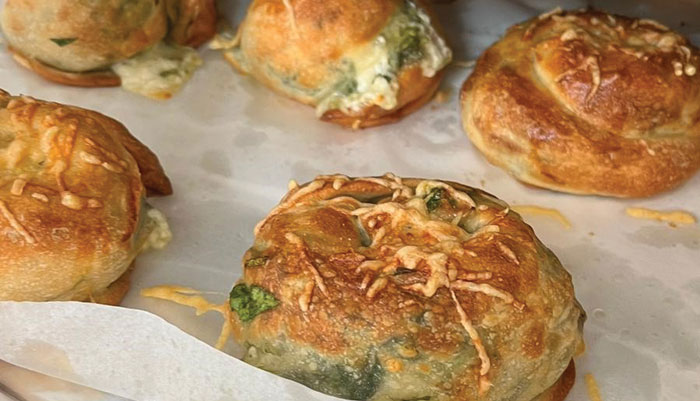A Memorable Mimouna
Mimouna is the joyous North African party that marks the end of Passover and the beginning of the agricultural season.

As the Sephardic Spice Girls, Sharon and I live our life on a calendar that is at least two weeks ahead of real time. We are always planning classes for the next holiday and cooking for articles that are way in the future.
Even as we write this article about Mimouna on Erev Pesach, Sharon and I have already celebrated a Mimouna. And when we posted pictures in our Instagram stories, one irate follower told us to check our dates and that we had it wrong.
She wasn’t wrong. Mimouna is the joyous North African party that marks the end of Passover and the beginning of the agricultural season. But Sharon and I had been invited to participate in a pre-Passover demonstration of a Mimouna celebration. Conceived as a way of sharing the beautiful traditions of her Moroccan heritage by talented film producer Lauren Avinoam of Mena Feast, the event we attended was capably organized by Toby Berkow of the Food Lab Project at Wilshire Boulevard Temple.
So on a bright, slightly windy Sunday, we set up a Mimouna table in the yard at the Brawerman Campus in West Los Angeles. We adorned our table with talismans of luck, fertility and prosperity. Five (plastic) gold coins in a bowl of flour. Five fava beans laid out on a pastry. Instead of a live goldfish in a glass bowl, I bought a very realistic-looking stuffed fish. There were roses and sheaves of wheat. Milk in a pitcher. Eggs in a bowl. Butter and honey to serve with Mufletas, thin pancakes that are the star of the Mimouna.
In North Africa, in the spirit of peaceful coexistence, the Muslim neighbors would bring the flour to Jewish homes after the sun had set, marking the end of Passover.
In North Africa, in the spirit of peaceful coexistence, the Muslim neighbors would bring the flour to Jewish homes after the sun had set, marking the end of Passover. Making Mufleta is a fine art — the dough is thin and soft and stretchy and you have to get the timing right to ensure a properly cooked pancake. Skillful chefs use their bare hands to flip each pancake, adding another pancake and flipping, until they land up with a huge stack. At this Mimouna, chef Zahava Atlit fed the crowd with fabulous mufleta, dripping with butter and honey and puffy, airy Sfinge (Moroccan doughnuts) that she whipped up on the spot. Sharon and I were in carb heaven as we inhaled her perfect, sweet creations.
Our good friend Penina Meghnagi Solomon (@JewishLibya) had a table overflowing with her homemade sweets, including the most incredible delectably sweet, light and crispy fijuelas, a deep-fried sweet pastry doused in a honey syrup, marzipan stuffed dates and almond cookies.
Lauren brewed Moroccan mint tea and a fabulous iced coffee drink. There were arts and crafts for the children and Israeli music pulsing in the background. It made me proud of my Moroccan heritage.
—Rachel
I like to tell people stories. I like to tell people that for 2,600 years, my ancestors thrived in Babylon, where they spoke a Judeo-Arabic. That is the language that my great-grandmothers Emmy Lulu and Emmy Toba spoke to me when I was a baby. A language that still stirs my soul when I hear it, but that I cannot speak so fluently. A language that wasn’t transmitted to my children and the next generation of my family.
I want my children to know more about our family history than just the stories I heard growing up. I grew up at a time when people were eager to discard the past and embrace the modern. The stories are too few and the black and white photos are mere glimpses into a world gone by.
As a young person, I took for granted that my grandparents would always be there to tell their stories and celebrate Shabbat and Jewish holidays. Time has a nasty habit of moving too quickly. Now it’s my turn to tell the story of past generations and transmit traditions.
Mimouna is a wonderful example of how closely Jewish and Moslem cultures coexisted throughout North Africa and the Middle East. The doors of Jewish homes were thrown open for all to enter and the tables were covered with sweets made from recipes common to both religions. Everyone wore brightly colored caftans and they greeted each other with Judeo-Arabic blessings of “tir’bah u’tissad,” may you prosper and succeed.
In Israel, Mimouna has always been a very popular and widely celebrated event. This year, it feels that it will be difficult to celebrate. But this year, when the chasm between Hebrew speakers and Arabic speakers seems like an unbridgeable divide, perhaps Mimouna can remind us of a shared past.
May the spirit of coexistence flourish once again. May we know the sweetness of true redemption, the freedom of our hostages and a speedy recovery for all who need one.
We hope you do celebrate the sweetness of life with our recipe for meringues (whipped up by my darling daughter Alexandra Gomperts) and Rachel’s amazing recipe for mufletas.
—Sharon

Sephardic Spice Girls Moufleta
4 ½ cups all-purpose flour
2 cups lukewarm water
¼ tsp yeast (optional)1 tablespoon sugar
¼ tsp salt
2 Tbsp oil, plus 1/2 cup oil (avocado or vegetable)
Butter, honey or Nutella, for serving
Sift flour and salt into a large bowl and make a well in the center. Add the yeast and sugar and slowly add water.
Mix the dough by hand until it is sticky but not smooth.
Pour 2 tablespoons of oil over the dough, cover with a towel and let rest for 30 minutes.
Divide the dough into golf ball-sized balls and set on a baking sheet.
Pour 1/2 cup oil over the balls, then turn balls over to completely cover with oil and let the dough rest an additional 15 minutes.
Lightly oil the counter and stretch each dough ball as thinly as possible.
Heat a nonstick frying pan and oil the surface by using a paper towel dipped in oil.
Place dough in the hot pan. When the dough is golden and bubbles a little, flip and place another piece of dough on top.
Continue to flip every few minutes, adding an additional piece of dough each time.
Remove the moufleta from the pan when there are 4 or 6 pieces of dough in the stack. Then start a new stack.
Traditionally served with sweet butter and honey but kids love it with Nutella.
Makes about 3 dozen.
Meringues
6 egg whites
1 1/2 cups sugar
1/4 tsp salt
4 tsp corn starch or potato starch
2 tsp white or apple cider vinegar
Preheat oven to 400°F. Line two baking sheets with parchment paper.
In clean bowl of a stand mixer, use the whisk attachment to beat egg whites, starting on low speed. As the eggs become foamy, gradually increase to high speed.
Once egg whites form stiff peaks, gradually add the sugar until it has all been incorporated.
When the mixture is thick and glossy, add the salt, corn starch and vinegar. Beat for 1 minute.
Place meringue into a piping bag and pipe onto prepared baking sheet.
Lower oven to 200°F and bake for two hours.
Leave in the oven to dry out overnight.
Store in airtight container until ready to serve.
Sharon Gomperts and Rachel Emquies Sheff have been friends since high school. The Sephardic Spice Girls project has grown from their collaboration on events for the Sephardic Educational Center in Jerusalem. Follow them on Instagram @sephardicspicegirls and on Facebook at Sephardic Spice SEC Food.







